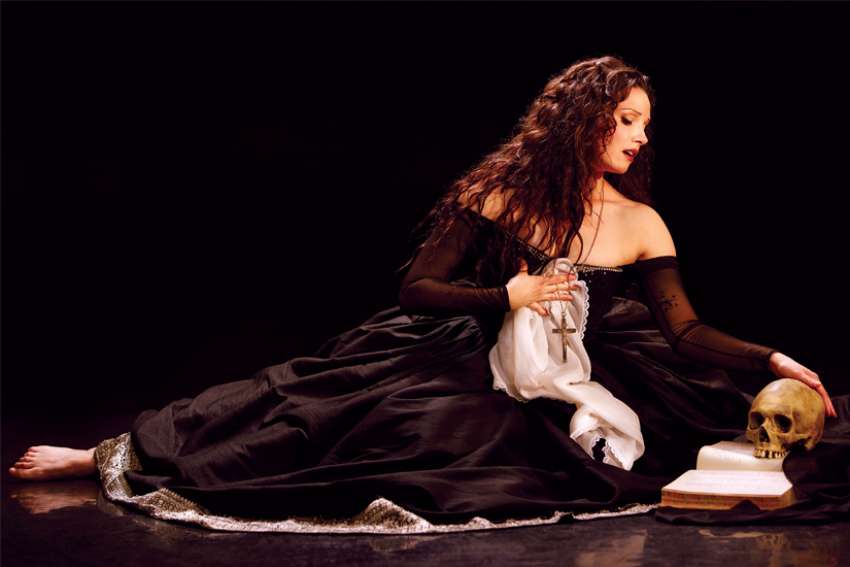“I want to draw a line in the sand for us in terms of mystery, for want of a better word,” artistic co-director Marshall Pynkoski told The Catholic Register. “I’m tired of having everything explained to me. I want there to be some things that I don’t understand, so I have to go away and think about them and try to figure them out.”
Inspired by a long history of Catholic visual art from Baroque paintings to 20th century advertising and experimental film, Pynkoski and his company hope to present Handel’s The Resurrection as a visual distillation of the mystical and spiritual experience of Mary Magdalene as she witnesses Christ’s death and resurrection. As both a musical and visual experience, Pynkoski promises a production that uses our senses to transcend the earthbound.
Handel’s The Resurrection, with its libretto by Carlo Sigismondo Capece, “is so reflective. It draws you in, in a way that is so incredibly intense,” Pynkoski said.
For a company known for its faithfulness to baroque traditions, the five performances at Toronto’s Koerner Hall between April 11 and April 19 are in fact quite untraditional, despite the period instruments and baroque aesthetic. The Resurrection is not, in fact, an opera. It was written as an oratorio — a concert piece without the staging, action and costumes of an opera.
It is undoubtedly true that Handel would rather have written an opera, but in Rome in 1708 there still existed a ban on opera, put in place five years earlier by Pope Clement XI. He had deemed this form of theatre as a catalyst for immoral behaviour. But the 23-year-old Lutheran George Friedrich Handel had been imported to Catholic Rome specifically to impress an opera-loving Roman public.
“When you think of what the German world was at that time, the German Church, to have arrived in Rome and be surrounded by everything that attracts your senses — I think, as an artist, as a great artist and a young man, (Handel) simply responded to that absolutely and naturally. He was also dying to show he was a genius,” Pynkoski said.
Handel and his fabulously wealthy patron, Marchese Francesco Ruspoli, did their best to get around the pope’s edict by staging this oratorio as theatrically as possible. They even snuck in the famous soprano Margherita Durastanti to sing the critical part of Mary Magdalene, despite the pope’s ban on female singers. Another case of “better to ask forgiveness than permission,” but Durastanti had to be replaced by a castrati singer after opening night.
Baroque intrigue aside, this 300-year-old work has a remarkably 21st-century feel. Capece’s libretto is an 18th-century feminist take on the Bible, not only casting Mary Magdalene as a strong protagonist and Apostle to the Apostles, but eschewing the then commonly accepted lie that she was a reformed prostitute. Capece also foreshadows the eco-theology of Pope Francis, by seeing the Resurrection as unlimited — not just the resurrection of Jesus but the redemption of all creation, especially the natural world.
No popes will intervene on Opera Atelier, and the full company of singers and dancers — plus the Tafelmusik Baroque Orchestra backing them up — intends to provide a lush, baroque and dramatic reading of the two-act clash between doubt and faith, between Heaven and hell, between life and death.
If a night at the opera doesn’t sound like contemplation, Pynkoski hopes to change your mind.
“When I speak of an experience that is reflective, that’s part of it,” he said. “We’re drawn in. We’re drawn into the dialogue. We’re drawn into the interior dialogue, which is so incredibly, beautifully supported by the music.”
Despite the title, Christ’s resurrection only comes at the end of the story.
“It is a rather thrilling moment when Mary Magdalene runs out onto the stage. It’s your classic messenger scene from 18th-century drama,” said Pynkoski.
The drama is perfectly Lenten in the 50 minutes it spends anticipating a resurrected Jesus. “O cruel recollection! Come, wring my heart! For in torment I shall find joy, as by the anguish of my mind, my love may be augmented, and then I feel within my breast some part of the agony of my Jesus crucified,” Mary Magdalene sings in Act One.
As she contemplates the nails that pierced Jesus hands and feet and the crown of thorns, dancers around her depict her imagination. The nails, the crown of thorns, the shroud and the tomb all make an appearance.
“It moves slowly,” said Pynkoski. “It moves at its own pace, without racing through anything. The way it’s presented — two ideas with the spiritual arguments that are happening between a rather amusing Satan and a smug angel; meanwhile the doubt, the anguish on Earth as people are trying to make some sense of what has just happened and what does it mean — (shows) the two women in that spectacular state of wanting to empathize with Christ’s suffering. They actually want to feel…. They’ve reached that point, that was very much championed it seems by the Catholic Church, that point of ecstasy.”
Mary Magdalene’s out-of-body experience is illustrated in sound by Handel. “That wonderful circular sort of music that is so dizzying,” is how Pynkoski describes it.
For Pynkoski the attractions of 18th-century Catholic spirituality and aesthetics are deeply personal.
“I was raised in an intensely Protestant home — fundamentalist, Evangelical, holiness movement,” he said.
In contrast, Catholic churches full of paintings and sculpture, incense, hushed tones and the uncertain melodies of chant make an appeal to the senses — an overture of physical beauty to hint at the glory of spiritual beauty.
“So I had none of that in my life,” Pynkoski said. “…The theatre world is full of people who have come from Evangelical Christian homes.”


